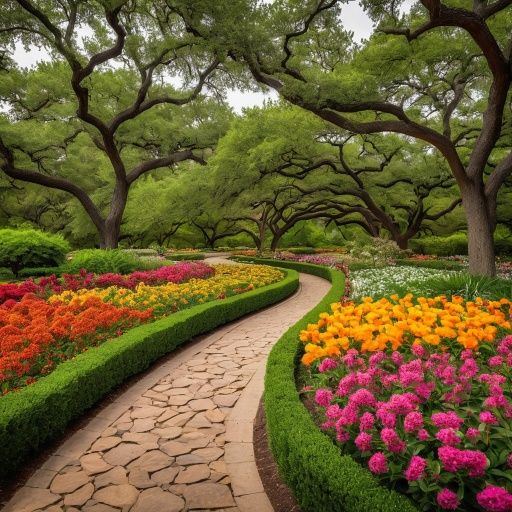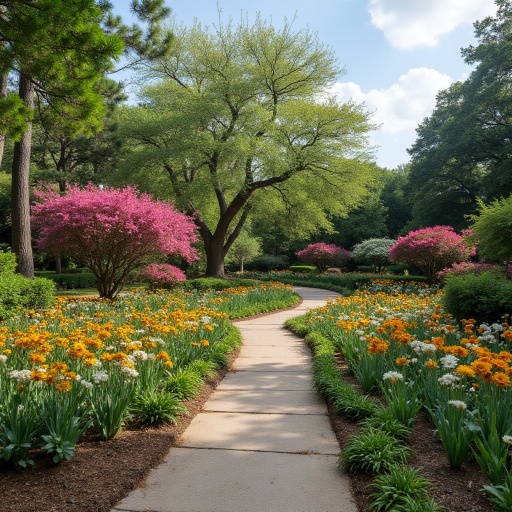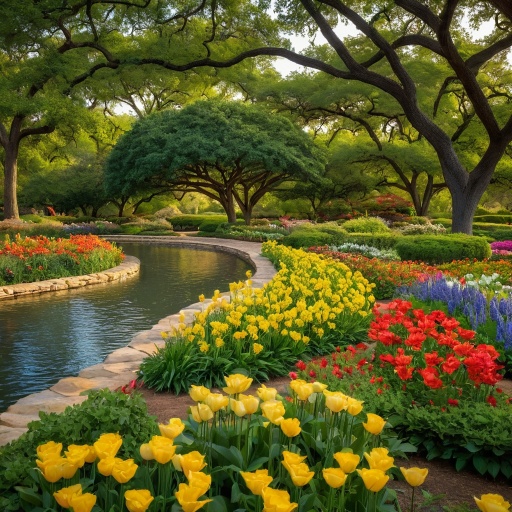Dallas Arboretum and Botanical Garden (Texas)

Did you know that thoughtfully designed gardens can lower stress levels by up to 40% while increasing property values by 5-15%? The Dallas Arboretum and Botanical Garden stands as a living testament to the transformative power of exceptional garden design ideas. As one of Texas’ premier horticultural destinations, this 66-acre wonderland offers endless inspiration for both casual gardeners and landscape enthusiasts. Whether you’re looking to reimagine your backyard oasis or simply appreciate masterful garden design, the Dallas Arboretum provides a perfect blend of beauty, education, and relaxation in one magnificent setting.
Information About the Dallas Arboretum and Botanical Garden
The Dallas Arboretum and Botanical Garden is a world-class botanical paradise located in East Dallas, Texas, along the southeastern shore of White Rock Lake. Founded in 1984 when the Dallas Arboretum merged with the DeGolyer Estate, this 66-acre garden showcases spectacular seasonal displays, diverse plant collections, and award-winning landscape designs.
The Arboretum features:
- 19 named gardens with distinct themes and design concepts
- Over 2,500 varieties of plants, trees, and flowers
- Historic mansions including the DeGolyer House and Camp House
- Seasonal festivals attracting over 900,000 visitors annually
- Educational programs for all ages
- Research facilities dedicated to plant conservation
What sets the Dallas Arboretum apart is its commitment to showcasing garden design ideas that work specifically in the challenging Texas climate, offering practical inspiration for home gardeners while maintaining extraordinary beauty throughout all four seasons.
Timing
A typical visit to the Dallas Arboretum requires approximately 3-4 hours to fully experience its diverse gardens and amenities. During special seasonal events like Dallas Blooms (spring) or Autumn at the Arboretum (fall), visitors often extend their stay to 5-6 hours to enjoy the enhanced programming and displays. Compared to the national average garden visit time of 1.5 hours, the Dallas Arboretum consistently engages visitors for significantly longer periods due to its expansive size and variety of attractions.
For those interested in deeper exploration of garden design ideas, consider planning:
- A half-day visit for casual enjoyment of main gardens
- A full-day visit during seasonal festivals
- Multiple visits throughout the year to witness the changing seasonal landscape designs
Step-by-Step Garden Tour for Design Inspiration
Step 1: Begin at the Entry Plaza and Paseo de Flores
Start your garden design adventure at the Entry Plaza, where the Paseo de Flores (Walkway of Flowers) provides an immediate immersion into sophisticated landscaping techniques. Notice how the grand allee of Italian cypress trees creates a strong directional element, a technique you can adapt in your own garden to establish sight lines and guide movement. The seasonal color beds demonstrate effective plant massing—using groups of the same plant rather than individual specimens—which creates visual impact even in smaller spaces.
Pro tip: Take photos of plant combinations that catch your eye. The Arboretum’s designers expertly pair complementary colors and textures that you can recreate at home.
Step 2: Explore the Margaret Elisabeth Jonsson Color Garden
This 6.5-acre garden showcases the power of mass plantings and seasonal color. During spring, over 350,000 bulbs and annuals create breathtaking displays. The garden’s design teaches valuable lessons about color theory in landscaping—complementary colors (opposite on the color wheel) create dynamic energy, while analogous colors (adjacent on the wheel) establish harmony.
Design takeaway: Note how the garden uses undulating borders and curved pathways to create visual interest and a sense of discovery—a technique that makes even small garden spaces seem larger.
Step 3: Study the Water-Wise Techniques in the Nancy Rutchik Red Maple Rill
This 80-foot-tall shaded stream demonstrates sophisticated water management through a series of streams and pools. The garden exemplifies how to incorporate water features sustainably by:
- Using recirculating systems to minimize water usage
- Positioning plants strategically to reduce evaporation
- Incorporating native species adapted to local rainfall patterns
The layered plantings of shade-loving perennials offer inspiration for woodland gardens or shaded urban lots.
Step 4: Examine the Structural Elements in A Woman’s Garden
This formal garden showcases the importance of hardscaping in garden design. Note how the stone walls, pathways, and fountains provide year-round structure, while seasonal plantings add changing color and texture. The garden demonstrates perfect balance between:
- Formal geometric elements (reflecting pools, symmetrical plantings)
- Softer organic forms (perennial borders, specimen trees)
- Transitional spaces that guide visitors between different garden rooms
This design approach can be scaled to any size property by creating distinct outdoor “rooms” connected by pathways or viewpoints.
Step 5: Discover Sustainable Design in the Rory Meyers Children’s Adventure Garden
Beyond its educational focus, this 8-acre garden demonstrates cutting-edge sustainable design practices including:
- Green roof technology that reduces energy costs while managing stormwater
- Habitat gardens that support local wildlife
- Renewable energy demonstrations
- Rainwater collection systems
- Native plant integration
These elements provide practical inspiration for environmentally responsible landscaping that homeowners can adapt to their own properties.

Technical and Artistic Information
General Information
The Dallas Arboretum and Botanical Garden occupies 66 acres along the southeastern shore of White Rock Lake in East Dallas, Texas. It officially formed in 1984 when the Dallas Arboretum merged with the DeGolyer Estate, though the properties have separate histories dating back to the 1940s.
Founder: The garden was established through the collective vision of the Dallas Arboretum Women’s Council, the Dallas Botanical Society, and the DeGolyer Foundation.
Geographical location: 8525 Garland Road, Dallas, Texas 75218, situated in USDA Hardiness Zone 8a.
Climate and Resources
The Arboretum experiences a humid subtropical climate with hot summers (average high 96°F/36°C) and mild winters (average low 37°F/3°C). Annual rainfall averages 39 inches, with precipitation distributed throughout the year. This climate creates both challenges and opportunities for garden design, demonstrating techniques for heat-tolerant landscaping relevant to many regions.
Water resources include White Rock Lake and sophisticated irrigation systems drawing from municipal supplies, with increasing emphasis on rainwater collection and conservation.
The Arboretum’s mission focuses on displaying outstanding plants adapted to the regional climate, developing educational programs for all ages, and conducting research beneficial to the Southwest region.
Garden Varieties and Distinctive Features
The Arboretum contains 19 named gardens, each showcasing different design approaches:
- The Margaret Elisabeth Jonsson Color Garden: Features dramatic seasonal displays with over 2,000 varieties of azaleas, tulips, and other flowering plants.
- The Nancy Rutchik Red Maple Rill: A peaceful stream garden bordered by 80 Japanese Maple trees, demonstrating shade gardening techniques.
- A Woman’s Garden: A formal garden featuring precise geometric designs, fountains, and reflecting pools, illustrating principles of balance and symmetry.
- The Lay Family Garden: Showcases naturalistic water features with cascading waterfalls and koi ponds, demonstrating how to create garden habitats.
- The Martha Brooks Camellia Garden: Houses over 500 camellia varieties, showing how to effectively use foundation shrubs in garden design.
- The Boswell Family Garden: Focuses on herbs and edible landscapes, demonstrating the integration of utilitarian and ornamental garden design.
- The Crape Myrtle Allee: 150-foot allee of mature crape myrtles showing the dramatic effect of repetition in landscape design.
- The Palmer Fern Dell: Displays shade-loving plants in a naturalistic setting, offering inspiration for woodland garden design.
- The Rory Meyers Children’s Adventure Garden: 8 acres of interactive educational exhibits integrating garden design with learning environments.
Distinctive Plant Patterns
The Arboretum is renowned for its exceptional:
- Trial Gardens: Testing grounds for new plant varieties suitable for Texas conditions, providing data-driven plant selection guidance for home gardeners.
- Native Texas Plant Collection: Showcasing indigenous species arranged in naturalistic communities.
- International Collections: Including the Chinese Lantern Garden and Japanese-inspired spaces that demonstrate cross-cultural design principles.
- Seasonal displays: Famous for “Dallas Blooms” featuring over 500,000 spring bulbs and “Autumn at the Arboretum” with more than 90,000 pumpkins, gourds, and squash.
Infrastructure and Facilities
The Arboretum offers comprehensive visitor amenities:
- Education Center: Houses classrooms and workshop spaces for gardening programs.
- DeGolyer House: A 21,000-square-foot historic mansion available for tours and events.
- Camp House: A Spanish-style historic home used for exhibitions.
- Hoffman Family Gift Store: Offers garden-related merchandise and plants.
- Multiple dining options: Including the DeGolyer Garden Café, Terrace Café, and seasonal food vendors.
- Tram service: For accessibility throughout the gardens.
- Simmons Pavilion: A 5,200-square-foot event venue for weddings and corporate functions.
- Rosine Hall: A 9,600-square-foot building for large events and exhibitions.
Annual Events and Festivals
Key annual events include:
- Dallas Blooms (February-April): The largest floral festival in the Southwest
- Summer at the Arboretum (May-August): Featuring summer plant displays and outdoor concerts
- Autumn at the Arboretum (September-October): With the nationally acclaimed Pumpkin Village
- Holiday at the Arboretum (November-December): Featuring the 12 Days of Christmas display
- Food and Wine Festival (March): Celebrating culinary arts
- Garden Gigs (Summer): Friday evening concerts
- Children’s Adventure Garden programs: Year-round educational activities
Accessibility and Admission
The Arboretum is open daily from 9am to 5pm, with extended hours during special events. General admission ranges from $12-20 depending on season, with discounts for seniors and children. Membership options provide unlimited admission and additional benefits.
The gardens are accessible via:
- Personal vehicle (parking fee: $15)
- DART public transportation (Bus Route 60)
- Rideshare services
- Bicycle (bike racks available)
Management and Community Impact
The Dallas Arboretum is governed by a Board of Directors and operated by a professional staff including horticulturists, educators, and administrators. The garden employs over 100 full-time staff and relies on more than 500 volunteers who contribute approximately 20,000 hours annually.
Annual visitation exceeds 900,000 people, with visitors from all 50 states and over 90 countries. Local economic impact is estimated at $75 million annually, supporting Dallas tourism and providing educational resources to over 100,000 schoolchildren each year.
Healthy Alternatives to Traditional Garden Visits
While the Dallas Arboretum offers an exceptional experience, consider these alternatives for complementary garden exploration:
- Texas Discovery Gardens: Located in Fair Park, this garden focuses exclusively on native plants and organic gardening techniques, offering additional sustainable landscaping ideas.
- Fort Worth Botanic Garden: Texas’ oldest botanical garden provides a different perspective on Japanese garden design and native prairie landscapes.
- Cedar Ridge Preserve: For those interested in naturalistic garden design, this 600-acre preserve demonstrates how to work with native ecosystems.
- Community Garden Tours: Many Dallas neighborhoods host seasonal garden tours showcasing residential landscaping solutions adapted to local conditions.
- Virtual Garden Design Workshops: The Arboretum offers online classes for those unable to visit in person, focusing on practical implementation of design ideas.
For families with diverse needs, consider:
- Early morning visits for sensory-sensitive individuals (reduced crowds)
- Evening concerts for music enthusiasts
- Photography walks for creative engagement
- Gardening workshops for hands-on learners
Introductory Suggestions for Garden Design Inspiration
To maximize your design inspiration at the Dallas Arboretum:
- Visit during transitional seasons (early spring or late fall) to observe how gardens maintain interest during challenging periods.
- Bring a sketchbook or digital tablet to record design ideas that resonate with you—particularly noting plant combinations, path layouts, and focal points.
- Take the guided “Design Principles Tour” offered monthly, where horticulturists explain the technical decisions behind various garden features.
- Photograph hardscape elements like walls, paths, and edging that create the structural backbone of successful gardens.
- Download the Arboretum’s plant database app to identify specimens that catch your eye and verify their suitability for your home conditions.
- Attend one of the “Designer’s Cut” workshops where landscape professionals demonstrate how to adapt Arboretum techniques to residential properties.
Common Mistakes to Avoid
When seeking garden design inspiration, avoid these common pitfalls:
- Ignoring scale considerations: According to landscape design surveys, 78% of homeowners initially select plants that will eventually outgrow their spaces. The Arboretum labels mature sizes—pay attention to these specifications.
- Focusing only on flowers: Research shows gardens with 30% structural elements (evergreens, hardscaping) and 70% seasonal interest maintain year-round appeal. Note how the Arboretum balances these elements.
- Overlooking maintenance requirements: Studies indicate homeowners spend an average of 4 hours weekly on garden maintenance. The Trial Gardens provide realistic assessments of plant performance and care needs.
- Attempting wholesale replication: Climate-appropriate design requires adaptation. Focus on design principles rather than exact plant selections that may not thrive in your specific conditions.
- Missing seasonal transitions: Visit the same areas in different seasons or review the Arboretum’s seasonal photo galleries to understand how spaces transform throughout the year.
Visitor Encouragement Tips
To fully engage with the garden design experience:
- Participate in “Early Morning Photography Walks” to capture design elements in optimal lighting.
- Join monthly “Garden Design & Wine” evening events where designers discuss current trends while touring the gardens.
- Download the self-guided “Design Elements Tour” from the Arboretum website before your visit.
- Engage with gardeners working on-site—they often share practical maintenance tips not found in guidebooks.
- Schedule your visit around seasonal demonstrations like “Summer Pruning Techniques” or “Fall Color Planning.”
- Consider a “Four Seasons Membership” to witness the complete design cycle and evolution of garden spaces throughout the year.
- Maintain a garden journal inspired by your visits, tracking ideas you implement and their success in your own landscape.

Conclusion
The Dallas Arboretum and Botanical Garden stands as an unparalleled resource for garden design ideas, offering 66 acres of inspiration adaptable to any scale. From formal gardens to naturalistic landscapes, it demonstrates practical techniques for creating beautiful, sustainable outdoor spaces even in challenging climates. Each visit provides fresh perspectives on color theory, spatial planning, and plant selection that can transform your own garden.
Ready to find your garden inspiration? Visit the Dallas Arboretum, share your experience in the comments below, or subscribe to our newsletter for seasonal gardening tips inspired by this Texas treasure.
Frequently Asked Questions
What’s the best season to visit the Dallas Arboretum for garden design ideas?
Each season offers unique inspiration. Spring showcases color combinations through Dallas Blooms, summer demonstrates heat-tolerant plantings, fall highlights structural elements and transitional design, while winter reveals the importance of evergreens and hardscaping. Serious garden enthusiasts should consider multiple visits throughout the year.
How can I adapt the Arboretum’s large-scale designs to my home garden?
Focus on design principles rather than exact replication. The Arboretum offers “Scale It Down” workshops specifically addressing this challenge. Key techniques include creating “garden rooms,” using repetition of key plants for cohesion, and incorporating structural elements that maintain interest year-round.
Are the plants used at the Arboretum available for purchase?
Many plants featured in the gardens are sold during the Arboretum’s seasonal plant sales held in spring and fall. The garden shop also carries select specimens, and the website provides a plant database with local availability information for featured species.
Does the Arboretum offer consultations for home garden design?
While the Arboretum doesn’t provide individual consultations, it offers monthly design workshops and maintains a referral list of landscape designers familiar with the Arboretum’s collections and techniques. The education center also hosts “Design Dilemma” sessions where gardeners can bring photos and questions.
How does the Arboretum maintain such pristine gardens, and what techniques can home gardeners adopt?
The maintenance approach emphasizes proper plant selection, soil preparation, efficient irrigation, and proactive pest management. Home gardeners can adopt these principles through the Arboretum’s “Sustainable Garden Maintenance” classes offered quarterly. Their data shows that proper initial design reduces maintenance by up to 60%.
